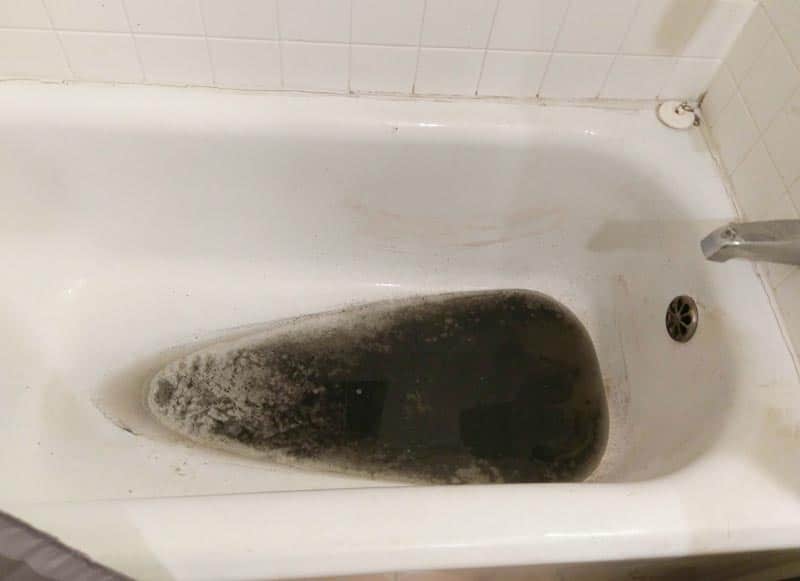Untangling the Causes of Waste in the Bathtub
Untangling the Causes of Waste in the Bathtub
Blog Article
This post down the page in relation to Why is Sewage Backing Up Into My Bathtub? is totally entertaining. Read it for your own benefit and decide what you think of it.

Sewer backup in the bathtub can be a distressing and unsanitary issue for any kind of property owner. Not just is it troublesome, however it likewise presents major wellness risks and shows underlying issues with the plumbing system. Understanding why sewage is turning up with the bathtub is essential for taking ideal action to deal with the issue effectively.
Introduction to the Issue
Typical Factors for Sewer Back-up
Clogs in the Sewer Line
One of one of the most typical root causes of sewer back-up is a clog in the sewer line. This can happen as a result of the buildup of debris, oil, or foreign items in the pipelines, avoiding proper flow and causing sewer to back up right into your bath tub.
Tree Root Breach
Tree roots looking for dampness and nutrients can infiltrate sewage system lines through tiny fractures or joints. Over time, these origins can grow and increase, triggering substantial damages to the pipes and causing sewer backup issues.
Comprehending the Trouble
When sewer draws back up into the bathtub, it's a clear sign of an issue with the drainage system. The wastewater that needs to be moving away from your home is rather locating its way back into your living space, which can lead to considerable damage and health hazards.
Prospective Reasons
A number of variables can add to sewer back-up in the bath tub. From obstructions in the sewer line to issues with the plumbing infrastructure, identifying the origin is vital for locating an option.
Aging Infrastructure
Older homes might have outdated plumbing systems that are more susceptible to corrosion, fractures, and wear and tear. As pipes age, they come to be extra vulnerable to leaks and blockages, raising the probability of sewage back-up cases.
Heavy Rainfall or Flooding
Throughout durations of heavy rainfall or flooding, the drain system may become overwhelmed with excess water, creating back-ups and overflows. This can lead to sewage backing up into bathtubs and various other components inside the home.
Indications of Sewage Backup
Foul Odors
Undesirable smells rising from drains or fixtures, particularly in the restroom, might suggest sewer backup concerns. These smells are typically solid and relentless, signaling a trouble that calls for immediate attention.
Slow Draining Fixtures
Bathtubs, sinks, and bathrooms that drain pipes gradually or not in any way could be experiencing sewage backup. If numerous components are impacted simultaneously, it's likely that the issue stems from a typical factor, such as the main drain line.
Gurgling Sounds
Unusual gurgling or bubbling noises coming from drains when water is running somewhere else in your home are a measure of air entraped in the plumbing system. This air buildup can arise from sewer backup and must be examined immediately.
Health Risks Associated with Sewage Backup
Contamination of Water System
Sewer back-up can infect the supply of water in your home, posing a major health danger to you and your family. Exposure to polluted water can bring about gastrointestinal issues, skin infections, and other health problems.
Mold and mildew Growth
Wetness from sewage back-up can produce excellent conditions for mold and mildew development in your house. Mold and mildew spores can worsen respiratory system issues and cause allergic reactions in delicate people, making prompt cleaning necessary.
Spread of Illness
Sewage consists of unsafe microorganisms, infections, and bloodsuckers that can create a series of diseases, consisting of hepatitis, cholera, and gastroenteritis. Entering into contact with sewer or infected surface areas places you at risk of infection.
Tidying up After Sewer Back-up
Disinfection Procedures
Completely decontaminate and sanitize impacted areas after sewer backup to remove unsafe bacteria and stop mold development. Use suitable cleaning items and safety equipment to ensure safe and efficient cleaning.
Reconstruction of Impacted Locations
Repair any damages to floor covering, wall surfaces, or fixtures triggered by sewer backup. Depending on the degree of the damage, you may need to replace carpeting, drywall, or other materials to restore your home to its pre-loss condition.
Immediate Actions to Take
Switching Off Water System
In the event of sewage backup, it's important to switch off the water to avoid additional contamination and damages. Situate the major water shutoff valve in your house and shut it off until the issue can be fixed.
Calling a Professional Plumber
Managing sewage backup is not a DIY task. Call a licensed plumber with experience in dealing with sewage-related concerns to analyze the circumstance and do required fixings or cleanings.
Avoiding Contact with Contaminated Water
Up until the sewer backup is resolved, stay clear of contact with polluted water to prevent the spread of germs and pathogens. Wear safety equipment if you should be in the affected location and clean your hands extensively later.
Safety nets
Regular Upkeep of Drain Lines
Set up normal inspections and maintenance of your sewage system lines to identify and attend to potential issues prior to they rise right into major issues. This can consist of cleaning particles, examining for tree root intrusion, and fixing any type of damaged pipelines.
Setting Up Bayou Valves
Take into consideration mounting bayou shutoffs in your plumbing system to avoid sewer from flowing back into your home during periods of heavy rainfall or flooding. These valves immediately close when water draws back up, protecting your residential or commercial property from contamination.
Appropriate Disposal of Family Waste
Prevent purging anything apart from bathroom tissue and human waste down the bathroom to avoid blockages and blockages in the sewage system line. Dispose of grease, oil, and various other house chemicals correctly to lessen the risk of plumbing issues.
Why is Sewage Coming Up Through Your Bathtub?
Reasons You May Have Sewage in Your Bathtub
All the drains in your home lead down different pipes to get to the main sewer line. If you’re seeing sewage in the bathtub, the problem is that the main sewer line is clogged up, which is causing the water running through other drains to be pushed back into other pipes. The problem isn’t the bathtub, but the main line. The sewer line can get backed up by anything that goes down the drain, from food waste, hair and soap particles to jewelry or children’s toys. Tree branches or dirt can also impact the sewer line. If you’re seeing sewage in the bathtub, you have a big problem that usually needs a professional plumber. Trying to fix this problem without the right tools or knowledge can lead to bigger plumbing problems.
Fixing a Clogged Sewage Line
Although you shouldn’t try to fix the clogged sewer line on your own, you may be able to mitigate the issue until you can get a plumber to your home. A plunger isn’t going to help, because it won’t be able to reach the sewage drain to unblock the problem.
Turn Off Water
Find the main shutoff valve to your home to turn off the water. This prevents more water from going down the drain which is only going to flow back into your bathtub.
Snake the Toilet and Drain
Start by using a drain pipe snake to clean out the toilet drain. Rotate the snake clockwise when you push the snake down. As you pull it out, the snake should spin counterclockwise. Follow up by snaking out the bathtub drain. If you are successful, both the toilet and shower will drain efficiently. If you’re not successful, you probably have a bigger problem than your tools and experience can manage.
Contact a Professional Plumber
Pros have the tools to find the source of the problem and the experience to manage big blockages without causing more damage to your pipes. It can save you a lot of stress by contacting the professionals sooner rather than later.
Identify the Early Signs of a Clogged Sewage Line
If you’re gearing up for a holiday family gathering or just want to avoid the hassle of a clogged sewage line in your home, make sure you recognize the signs of a clogged sewer line.
Slow drains are a sign of a sewer line problem. Gurgling drains from any drain in your home indicate that you may have an obstruction in the drains. If your toilet keeps getting clogged, it might be a problem with the sewer line. When you see laundry water or water from the dishwasher in different sinks in the home, it’s an indication that your sewer drain is beginning to get backed up. These symptoms can often be “fixed” temporarily to get through a day or week before you start seeing the same problem. When it comes to plumbing problems, you want to fix the root of the problem instead of muddling through. The clog will not go away on its own.
https://handymanconnection.com/mississauga/articles/why-is-sewage-coming-up-through-your-bathtub/

Do you appreciate reading about Why is Sewage Backing Up Into My Bathtub?? Create feedback down below. We will be happy to hear your responses about this post. In hopes that you come back again in the future. Appreciated our post? Please share it. Let someone else locate it. Thanks for taking the time to read it.
Schedule A Service Call
Report this page